Phototherapy is a promising natural solution for gum disease that uses targeted light therapies to promote healing and reduce inflammation. By employing specific light wavelengths, it generates reactive oxygen species that effectively combat harmful bacteria while enhancing tissue repair. Treatments like red and blue light therapy can alleviate pain, decrease bacterial load, and help regenerate gum tissue. Phototherapy is safe, non-invasive, and offers quicker recovery times compared to traditional methods. If you're interested in exploring how this innovative approach can improve your oral health, you'll find additional insights on its benefits and applications.
Understanding Phototherapy
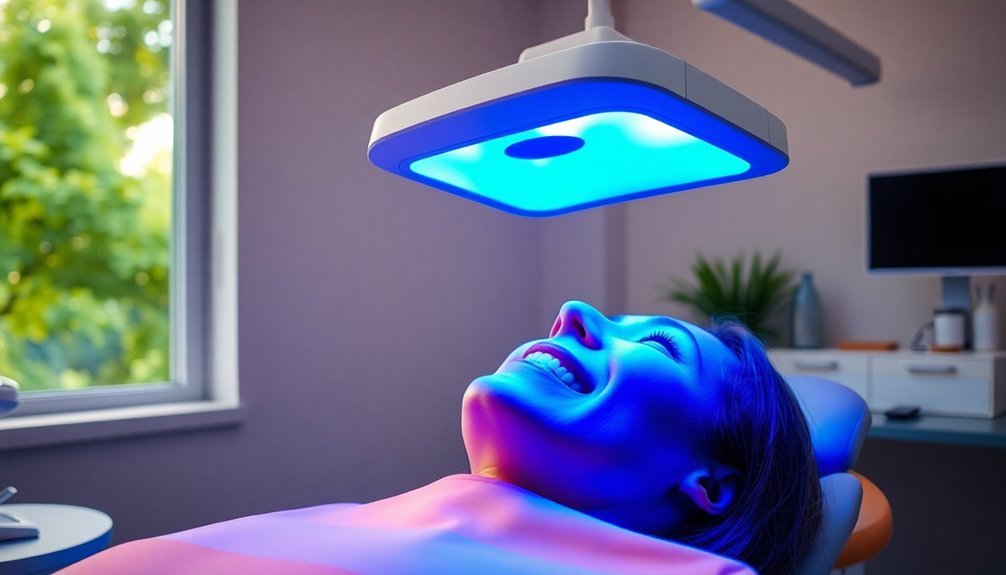
Phototherapy is a cutting-edge treatment option that harnesses light to target various oral health issues, especially gum disease. This innovative approach utilizes a photoactive dye, known as a photosensitizer, which gets activated by specific light wavelengths. When activated, it transfers energy to oxygen, creating toxic oxygen species such as singlet oxygen and free radicals. These reactive species effectively damage cellular components, leading to cellular injury or death, making it particularly effective against harmful pathogens without affecting surrounding healthy tissues.
There are different types of phototherapy. Photodynamic therapy (PDT) tackles multiple issues, including oral cancer and infections. Meanwhile, photobiomodulation, or low-level light therapy, employs red and near-infrared light to enhance tissue repair and reduce inflammation. Importantly, red light therapy specifically targets cellular energy production, promoting healing and regeneration. The effectiveness of these light wavelengths lies in their ability to increase cellular energy through mitochondrial activation. This not only promotes tissue repair through increased blood flow but also modulates reactive oxygen species for beneficial therapeutic effects. With various applications in dentistry, phototherapy shows great promise in enhancing oral health and treating complex conditions like gum disease, including its ability to enhance healing of oral tissues after dental procedures.
This new addition highlights the relevance of accelerated wound healing through red light therapy in the context of phototherapy for gum disease.
Benefits for Gum Disease
Light-based therapies offer numerous benefits for managing gum disease, providing patients with effective and non-invasive treatment options. By utilizing blue light, you can rapidly reduce the bacterial load in your mouth, killing harmful pathogens in as little as 15 to 60 seconds. This not only promotes gum healing but also contributes to reducing the progression of periodontal issues. Furthermore, regular use of light therapy helps decrease the presence of bad bacteria, enhancing your overall oral health.
Red light therapy comes into play by easing inflammation and pain linked to conditions like gingivitis and periodontitis, making your recovery more comfortable. With photodynamic therapy, you'll notice lower bleeding on probing and shallower pockets, enhancing your overall periodontal health.
Furthermore, these therapies stimulate blood circulation in your gums, fostering tissue regeneration essential for maintaining healthy gums. They also accelerate the healing of oral tissues post-treatment, allowing you to recover faster and with less discomfort.
As an added bonus, blue light treatments help reduce teeth sensitivity, making dental procedures much easier.
Incorporating phototherapy alongside traditional treatments, like scaling and root planing, can greatly improve your treatment outcomes, leading to healthier gums and a brighter smile.
Mechanism of Action
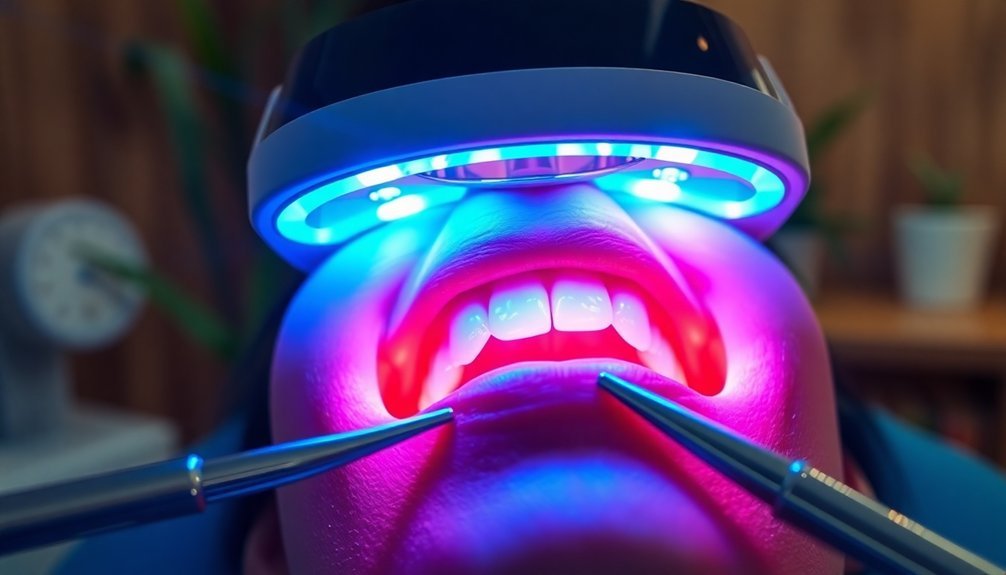
The mechanism of action behind phototherapy for gum disease hinges on the activation of photosensitizers like methylene blue (MB). This hydrophilic dye possesses a high quantum yield and excellent chemical stability, allowing it to adhere effectively to the negatively charged surfaces of microbial cells.
By penetrating bacterial cell walls easily, MB becomes activated when exposed to specific wavelengths of light, typically around 660 nm. Laser or LED light is employed for this process, as these light sources are cost-effective and align well with MB's absorption spectrum. The energy density, which is essential for effectiveness, depends on factors like power density, exposure time, and beam diameter. Once activated by the light, MB generates reactive oxygen species (ROS), which play an important role in oxidizing key cellular components, ultimately leading to the destruction of periodontal pathogens.
Moreover, MB-mediated antimicrobial photodynamic therapy (A-PDT) excels at eliminating bacterial cells within biofilms, which can be resistant to traditional methods. This treatment not only suppresses a wide range of bacteria but also promotes wound healing and tissue remodeling, making it a powerful option in managing gum disease effectively. Additionally, A-PDT shows potential in reducing antibiotic resistance compared to conventional therapies used in chronic periodontitis treatment.
Types of Light Therapy
Various types of light therapy offer promising approaches to managing gum disease.
Red light therapy uses low-level wavelengths to stimulate healing, reduce inflammation, and promote gum health. It can accelerate healing after dental procedures and increase blood circulation, making it ideal for daily dental care or supportive treatment post-procedure.
On the other hand, blue light therapy targets bacteria that contribute to gum tissue deterioration. It's often used in teeth whitening treatments, breaking up stains while also reducing plaque buildup and gingivitis. However, it doesn't provide the same therapeutic advantages for gum tissues as red light.
Laser therapy employs targeted light beams to remove inflamed gum tissue around teeth. This method is minimally invasive, leading to less discomfort and quicker healing compared to traditional surgery. It effectively reduces pocket depth and encourages gum reattachment, which can enhance your overall gum health.
Lastly, infrared light therapy, while less commonly used, helps in deeper tissue healing and shares benefits with red light therapy, like promoting regeneration and reducing inflammation.
Together, these light therapy options form a thorough approach to combatting gum disease effectively.
Applications in Dentistry
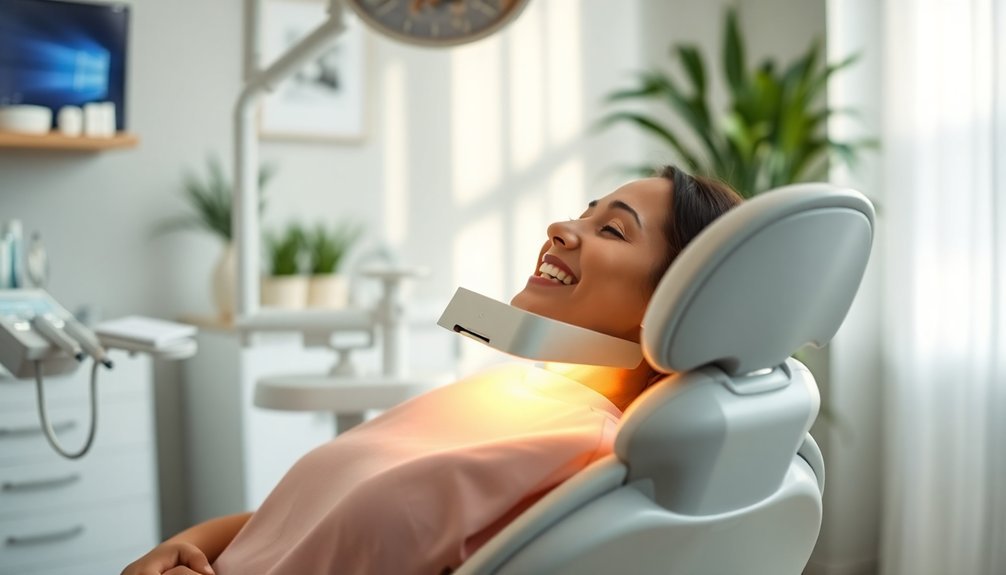
In your dental practice, you can leverage phototherapy to enhance gum treatment efficacy and pain management.
Techniques like laser therapy not only target inflamed tissue and harmful bacteria but also minimize discomfort during recovery.
Gum Treatment Efficacy
Effective gum treatment is essential for maintaining periodontal health, and recent advancements in phototherapy are showing promising results. Red light therapy considerably reduces inflammation, enhances tissue regeneration, and improves blood circulation in your gums.
If you're dealing with chronic periodontal disease, using this therapy as an adjunct to scaling and root planing can lead to better clinical outcomes. You may notice a decrease in both bacterial burden and inflammatory markers compared to conventional treatments.
Moreover, red light therapy accelerates oral tissue healing by boosting cellular energy production and stimulating repair mechanisms. Regular sessions not only promote the regeneration of both hard and soft tissues in extraction sockets and periodontal defects but can also lead to fewer deep periodontal pockets.
Additionally, this therapy has strong antibacterial effects. It targets harmful bacteria while preserving surrounding tissues, ensuring that your gums remain healthy.
In fact, combining red light therapy with other non-surgical treatments enhances their effectiveness, potentially reducing the need for invasive interventions.
Pain Management Benefits
When it comes to managing pain in dental procedures, light therapy stands out as a powerful option. This innovative approach reduces discomfort by increasing endorphin levels and decreasing neurotransmitter activity.
You'll find that red and blue light treatments work together to alleviate tooth sensitivity and overall oral pain. Photobiomodulation (PBM) also stimulates cellular repair, considerably easing post-procedure pain after events like extractions and surgeries.
One notable benefit of light therapy is its analgesic effects, which means you mightn't even need needles for procedures like cavity fillings. The targeted action of photodynamic therapy (PDT) can treat conditions like oral cancer with reduced pain.
Additionally, the specific wavelengths of light enhance blood circulation and lower inflammation, making your dental experience more comfortable.
Light therapy's anti-inflammatory properties mitigate swelling associated with dental issues such as gingivitis. By promoting healing and tissue regeneration, this therapy not only helps during procedures but also speeds up recovery, so you can get back to normal faster.
Advantages Over Traditional Treatments
Phototherapy offers significant advantages over traditional treatments for gum disease, making it an appealing choice for many patients. By opting for phototherapy, you can experience reduced inflammation and pain, enhanced healing, and a minimally invasive approach.
| Advantage | Phototherapy |
|---|---|
| Inflammation Reduction | Red and blue light therapies minimize swelling and pain effectively. |
| Enhanced Healing | Accelerates tissue repair and improves blood circulation in the gums. |
| Precision | Laser therapy precisely targets treatment areas while preserving healthy tissue. |
Using red and blue light, phototherapy not only reduces inflammation but also promotes rapid tissue regeneration, offering a quicker healing time than conventional methods. You'll also appreciate that laser treatments tend to involve less discomfort and a shorter recovery period.
Moreover, these therapies can seamlessly integrate with traditional procedures, enhancing overall results. Phototherapy fosters holistic gum health by addressing underlying issues and supporting cellular activity, making it an ideal choice for a thorough treatment plan. So, if you're looking for a modern and effective way to tackle gum disease, phototherapy is definitely worth considering!
Safety and Efficacy
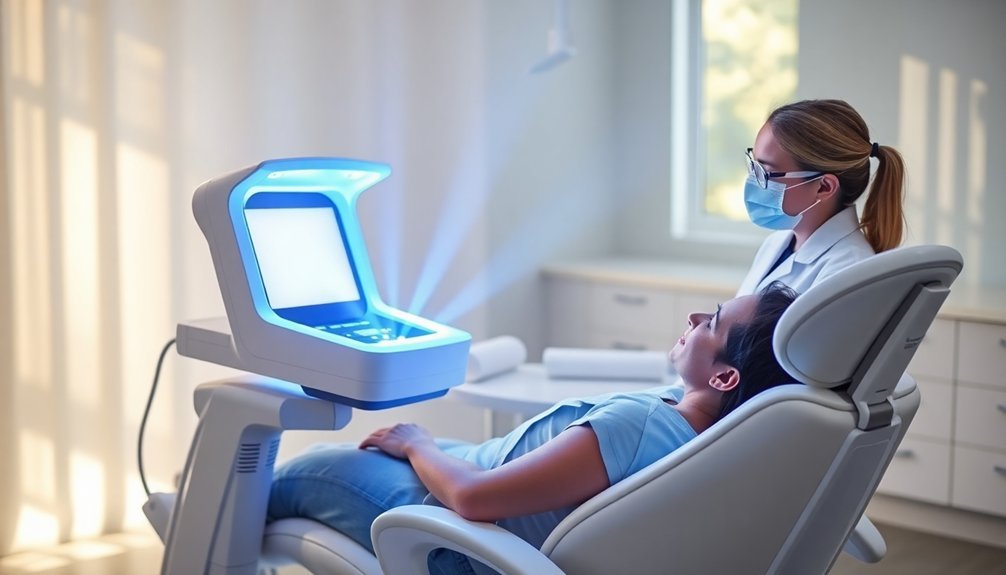
Understanding the safety and efficacy of phototherapy for gum disease is essential for making an informed treatment choice. You'll be glad to know that red light therapy is considered safe, with no reported side effects. It's a non-invasive method, ensuring your comfort during treatment.
Dental professionals administer the therapy, using protective measures like laser safety glasses to safeguard your eyes.
Regarding efficacy, numerous studies demonstrate that red light therapy effectively reduces inflammation in the gums. The targeted action of the light penetrates deep into gum tissue, diminishing swelling and promoting healing.
It also combats the bacteria responsible for periodontal disease through specific wavelengths. Notably, red light therapy stimulates tissue regeneration and enhances blood flow, accelerating recovery after gum surgery.
It plays an important role in improving overall oral health and preventing gum recession. When combined with traditional treatments, like scaling and root planing, its positive impact on gum diseases like gingivitis and periodontal disease is even more pronounced.
With strong clinical evidence supporting its effectiveness, phototherapy emerges as a valuable option in your dental care toolkit.
Patient Experiences
Many patients have reported quicker healing times after undergoing Red Light Therapy for gum disease.
You might find that this painless treatment not only reduces discomfort but also enhances your overall recovery.
As more people share their positive experiences, it's clear that this method offers significant benefits for oral health.
Improved Healing Time
Patients often report a remarkable improved healing time after undergoing laser gum therapy.
You'll typically find that your recovery period is about a week, which is much shorter than with traditional surgical methods. Many patients return to work within 24 hours of their procedure, allowing you to get back to your routine quickly.
The laser treatment results in minimal bleeding and swelling, largely because it doesn't involve a scalpel or sutures.
This means there's less chance of complications and a quicker healing process. You'll also notice that less healthy tissue is lost during the procedure, as laser therapy removes only the infected gum tissue.
This preservation of intact gum tissue contributes to faster recovery.
Moreover, the therapy stimulates your gum tissue's regeneration and encourages it to reattach to tooth roots.
Improved blood flow and increased collagen production result from the red light therapy, promoting healthier gum tissues.
As a result, you experience quicker healing and tissue repair, meaning your oral health will improve considerably in a shorter amount of time.
Pain Reduction Benefits
Experiencing discomfort during dental procedures can often heighten anxiety, but with laser gum therapy, you'll find significant pain reduction benefits. This innovative approach produces an analgesic effect, which means you won't necessarily need needles or injections during your visit.
Patients frequently report less pain and discomfort during treatments like cavity fillings, deep cleaning, or even root canals. After procedures such as tooth extractions and gum surgeries, many have found reduced soreness and tooth sensitivity, making recovery smoother.
The gentle red light therapy not only alleviates pain but also reduces inflammation, promoting healthier gum tissues. Increased blood circulation allows for quicker healing and decreases swelling, leading to a more comfortable experience overall.
Moreover, with laser therapy, you'll lessen your reliance on habit-forming narcotic drugs for pain management. You can often manage post-treatment discomfort with simple over-the-counter anti-inflammatory medications.
Even if you experience chronic conditions like gum disease or TMJ pain, phototherapy provides a non-invasive solution that can help regulate symptoms and promote long-term oral health. Say goodbye to unnecessary pain and hello to a more pleasant dental experience!
Who Can Benefit?

Individuals struggling with periodontal disease can find significant relief through phototherapy. If you're experiencing the discomfort of gum inflammation, targeted light therapy can help reduce this inflammation and promote healing.
It's designed to eliminate bacteria without harming surrounding tissues, making it a safe option for those with periodontal issues.
Are your gums receding? Red light therapy stimulates tissue regeneration, enhances blood circulation, and supports collagen production, all essential for halting gum recession.
You won't experience pain, as this non-invasive treatment has no reported side effects.
If you've recently undergone dental procedures like tooth extractions, light therapy speeds up your recovery. It minimizes discomfort and reduces downtime, allowing you to return to your regular routine faster.
Moreover, if you're prone to oral infections, phototherapy can help manage this too. Treatments like UV light therapy kill harmful bacteria that lead to ulcers or mucositis.
Future of Phototherapy in Dentistry
The future of phototherapy in dentistry looks promising as innovative approaches continue to emerge, transforming how dental professionals treat gum disease and other oral conditions.
You'll find that photodynamic therapy (PDT) is already showing effectiveness against periodontal diseases, considerably reducing bacterial loads. Its use in endodontic treatments enhances outcomes by decreasing pain and bacterial presence.
As technology advances, the development of new photosensitizers and oxygen self-sufficient nanoplatforms boosts PDT efficacy, tackling challenges like deep tissue hypoxia.
You can expect specific wavelength lasers to be optimized, making light therapies even more effective in clinical settings.
The safety profile of PDT is also worth noting; it activates photosensitizers with minimal risks, promoting healing while targeting infection.
Ongoing clinical trials are revealing even more applications, and combo therapies may offer enhanced results.
As regulatory acceptance increases, widespread adoption of phototherapy in dental practices seems imminent.
With the integration of nanotechnology and promising research, you can look forward to more effective and efficient treatments that not only address gum disease but also improve overall oral health.
Frequently Asked Questions
How Long Does a Typical Phototherapy Session Last?
A typical phototherapy session lasts about 10-20 minutes, but it varies based on your specific needs and the severity of the condition. Your dental professional can provide guidance on the right duration for you.
Are There Any Side Effects to Phototherapy Treatments?
Yes, there're side effects to phototherapy treatments. You might experience temporary gum inflammation, mild discomfort, or changes in tooth color. Regular check-ups are essential to monitor your progress and mitigate any risks.
Can Phototherapy Be Used for Other Dental Conditions?
Yes, you can use phototherapy for various dental conditions. It effectively reduces inflammation, speeds up healing, decreases tooth sensitivity, and aids in treating TMJ disorders and soft tissue lesions, offering a holistic approach to oral health.
How Many Sessions Are Usually Needed for Effective Treatment?
The number of sessions you need varies. Usually, a few sessions are enough to see results, but more severe conditions might require additional visits. Following your dentist's guidance will guarantee effective treatment for your individual situation.
Is Phototherapy Covered by Dental Insurance Plans?
Dental insurance plans usually cover medically necessary treatments, so whether phototherapy's covered depends on your specific plan. Check with your provider for eligibility, potential pre-treatment authorization, and if it's classified as a covered service.
In Summary
In summary, phototherapy offers a promising, natural approach to combat gum disease. With its various benefits, including enhanced healing and reduced inflammation, it's becoming a valuable tool in modern dentistry. You can take comfort in knowing that this innovative treatment is backed by research and positive patient experiences. If you're struggling with gum issues, consider discussing phototherapy with your dentist. As technology advances, the future of this therapy looks bright for maintaining oral health.

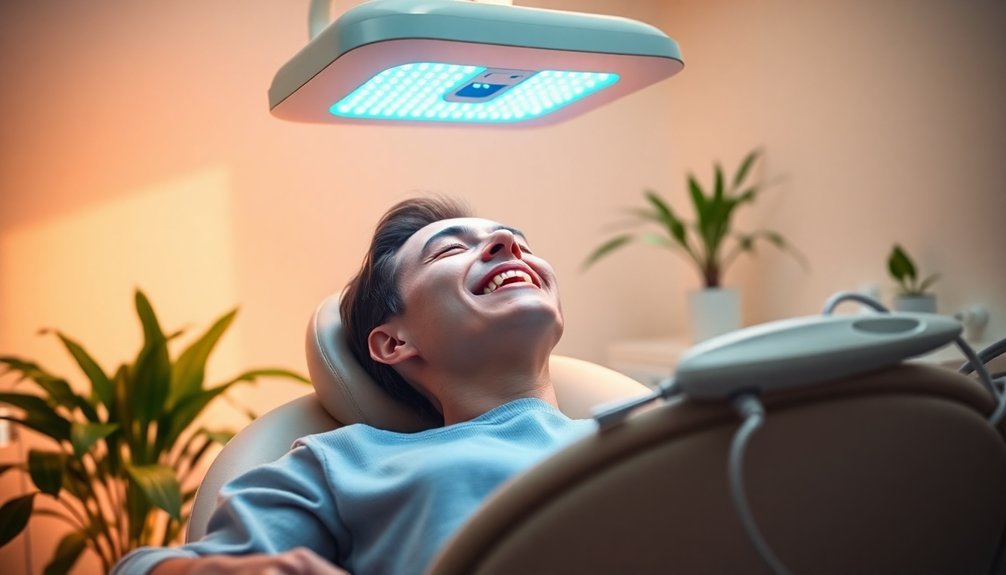



Leave a Reply